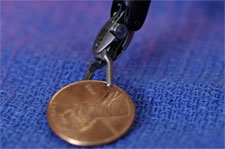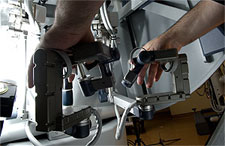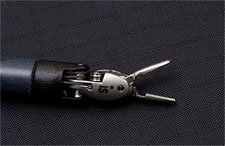Robotic Surgery
 The da Vinci Surgical System is the only commercially available technology that can provide the surgeon with the range of motion, fine tissue manipulation
capability and 3-D visualization characteristic of open surgery, while simultaneously allowing the surgeon to work through tiny incisions typical of
laparoscopic surgery.
The da Vinci Surgical System is the only commercially available technology that can provide the surgeon with the range of motion, fine tissue manipulation
capability and 3-D visualization characteristic of open surgery, while simultaneously allowing the surgeon to work through tiny incisions typical of
laparoscopic surgery.
The da Vinci System has three main parts: the console, where the surgeon sits to operate the robot; the patient side cart, which
is positioned over the operating table and contains the arms that hold the instruments; and a third cart which provides a view of the surgery for the
other doctors and nurses in the room. When the surgeon looks into the console, he sees a three-dimensional view of the patient’s internal organs
and the surgical instruments, similar to what he would see in an open operation.
 Unlike an open operation, the camera can magnify the image, creating better visualization. The arms of the robot on are controlled by the surgeon
using hand controls. Perhaps the largest advantage of the robot is in the design of the instruments. Unlike most laparoscopic instruments (which can
only move in certain directions) the da Vinci’s instruments are wristed. The surgeon can manipulate the instruments in multiple directions,
giving the surgeon freedom similar to that of an open platform.
Unlike an open operation, the camera can magnify the image, creating better visualization. The arms of the robot on are controlled by the surgeon
using hand controls. Perhaps the largest advantage of the robot is in the design of the instruments. Unlike most laparoscopic instruments (which can
only move in certain directions) the da Vinci’s instruments are wristed. The surgeon can manipulate the instruments in multiple directions,
giving the surgeon freedom similar to that of an open platform.
There are limitations to robotic surgery. Unlike an open operation, the surgeon cannot feel the organs. When using the instruments to touch the organs,
there is no tactile feedback, so surgeons must be extra vigilant about where each instrument is, in order to avoid damage to the organs. Finally, the
da Vinci requires use of instruments that are manufactured only by Intuitive Surgical, Inc. If a procedure requires an instrument that is not currently
available through the manufacturer, that part of the procedure must be completed laparoscopically.
Robotic surgeries have led to less invasive cancer surgeries with decreased pain and faster recovery times for patients. Because of the reduced size of
the incisions, hospital stays are often shorter, with some patients even able to go home the next day.
 During robotic surgery, several instruments, including a camera called a laparoscope, are inserted into the patient’s abdomen through small
incisions. These instruments include scissors, graspers, and other instruments modeled after the typical instruments used in traditional open procedures.
During robotic surgery, several instruments, including a camera called a laparoscope, are inserted into the patient’s abdomen through small
incisions. These instruments include scissors, graspers, and other instruments modeled after the typical instruments used in traditional open procedures.
Robotic surgery can help surgeons overcome many of the challenges presented by the open or laparoscopic surgery. We have one of the largest experience
with comprehensive robotic surgery in treating invasive bladder cancers with total bladder removal and urinary diversions (also known as Radical Cystectomy).
Dr. Singh is a leader in applying the robotic-assisted da Vinci S Surgical System to combine extremely precise movements with three-dimensional
imaging to achieve excellent surgical results.
Potential benefits of Robotic surgeries include:
- Less blood loss, pain and visible incisions
- Shorter hospital stays and recovery time
- Fewer post-operative complications
- Quicker return to normal activities
Dr . Singh is a fellowship-trained urological oncologist with one of the largest experiences in the use of robotic surgery as a treatement for all forms
of urological cancers.
|